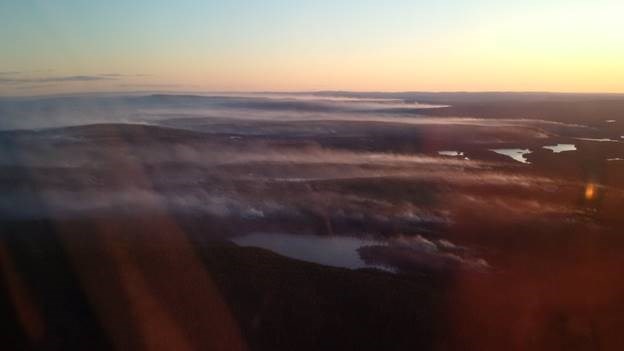While forest fire activity in the Cochrane area has been quiet, there are now 12 active fires, according to Aviation, Forest Fire and Emergency Services (AFFES).
Crews are also battling new fires in the Hearst area. As of last night, there were 66 active fires in the northeast region. Of those, 28 are not under control and 38 are being held, under control or being observed.
Located west of Tomorrow and Yesterday lakes, Cochrane 14 is 400 hectares and is not under control. The AFFES says sprinklers are being used on structures as a precautionary measure.
Cochrane 8 is at 85 hectares and also not under control. Four crews, along with waterbombers and other aircraft were being used at the scene yesterday.
According to the AFFES, “good progress” is being made at the Cochrane 9 fire and Cochrane 12 is three hectares and under control.
There are also five fires “being observed to allow the natural benefits of fire on the landscape, there are no values threatened in the area of these fires.”
Hearst 12, which is northeast of the Mattagami River, is 487 hectares and not under control.
Last night there were two new starts.
Hearst 13, which is 200 hectares and located 37 kilometres north of Highway 11 and southeast of Jog Lake, and Cochrane 16 south of Natogami Lake. Both fires are not under control.
Incident management teams continue to work in three priority areas: River Valley cluster, Lake Temagami cluster, and Lady Evelyn cluster.
The AFFES says River Valley includes two fires that aren’t under control. They are North Bay 62, which covers 2,500 hectares and is not under control, and North Bay 42 that is at 350 hectares. The organization says steady progress is being made on both fires.
In Temagami, the weather conditions are helping firefighting efforts on all the fires in the cluster.
Three fires – North Bay 53, 65 and 93 — have been called out. While crews are still at the scene of seven other fires, they are considered under control.
“North Bay 69, which previously caused the evacuation of 20 homes in the Temagami area, is now under control (UCO). Firefighters, are now focusing on working their way deep into the interior of the fire to check for hot spots,” reads the AFFES news release.
Crews hope that a controlled burn in the Lady Evelyn cluster “will bring the fires edge up to natural boundaries, further reducing the risk of fire spread and eliminating the need for ground crews in that area.”
Yesterday, heavy helicopters were bucketing water onto North Bay 72, which is at 11,453 hectares. With high temperatures and low humidity, the AFFES said the fire was more aggressive.
Resources from across Canada as well as Minnesota have been brought in. In the coming days, further support of additional crews and equipment from Wisconsin, Newfoundland, Saskatchewan, and the Northwest Territories is expected.
